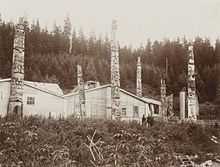Charles F. Newcombe

Charles Frederick Newcombe (15 September 1851 - 19 October, 1924) was a British botanist and ethnographic researcher. He is known for his work with the native people of Canada.
Biography
Newcombe was born in Newcastle-upon-Tyne, England, as the eighth of fourteen children. His parents were William Lister Newcombe (1817-1908) and Eliza Jane (Rymer) (1816-1888), who were both from Yorkshire.[2]
Newcombe received his MB from the University of Aberdeen in 1873 and his MD in 1878. He married Marian Arnold (1857-1891) in 1879 and for a number of years he was in general practice in the Lake District.[2]

In 1884, he established a general practice in Hood River, Oregon. He moved in 1885 with his family to Victoria, British Columbia. In 1889, he moved back to Victoria and worked at the "Insane Asylum" in New Westminster. His wife Marian died after the birth of their sixth child in 1891, leaving him with two daughters and four sons.
With his eldest three children he returned to England and participated in geological and natural history studies at the British Museum and the University of London.[1] He ceased to practice medicine after 1894.
Newcombe began to interest himself in the botany of North America and made many trips to Haida Gwaii (formerly the Queen Charlotte Islands) by boat. In the process he became very interested in the Haida and started to collect their artifacts to "preserve" them from, what was then thought to be, the demise of the native culture.[2] Newcombe and others were driven by the "fear that 'pure' Northwest Coast cultures were disappearing through depopulation and assimilation". In 1897, George Amos Dorsey asked him to collect Haida artifacts for the Field Columbian Museum in Chicago. Dorsey, an American, was known for his haste and he had to advise James Deans who had been a guide in the area that he should just keep quiet. This was required as the local missionary John Henry Keen lambasted Deans and his unidentified, but American, collaborators for desecrating the graves of the local natives in their hunt for Northwest Coast artifacts.[3]
Newcombe also acquired many totem poles for the Royal British Columbia Museum, the Pitt Rivers Museum in Oxford, the Totem pole for the British Museum, Kew Gardens, and museums in Cambridge, Liverpool[4] and Sydney. In 1904, he went with six Vancouver Island Native Americans and their medicine man to the World's Fair held in St. Louis to show their crafts and culture.
He also conducted biological and geographic research, such as on local (British Columbia) mollusks and paleontology. In 1913, he led a Commission studying the effect of sea lions on the salmon industry. In 1914, he prepared a report on the circumnavigation of Vancouver Island. Much of his work, including collection of plants, mollusks, fossils, aboriginal artifacts and information, was done with the help of his youngest surviving son, William Henry Arnold Newcombe (1884-1960).
He died in 1924 in Victoria, British Columbia, after catching a cold on a sailing expedition.[2]
See also
References
- ↑ 1.0 1.1 "Dr Charles F. Newcombe". Collection database search. British Museum. Retrieved 24 October 2010.
- ↑ 2.0 2.1 2.2 2.3 Charles F. Newcombe in Dictionary of Canadian Biography Online
- ↑ Cole, John (1995). Captured heritage: the scramble for Northwest Coast artifacts p175. UBC Press.
- ↑ Charles F. Newcombe at Liverpool Museum website, accessed 24 October 2010
|